Classical CDs Round-Up 17 | reviews, news & interviews
Classical CDs Round-Up 17
Classical CDs Round-Up 17
Russians, Norwegians and Germans; polyphony, brass and pianola: the latest releases
This month, we’ve some virtuoso pianola, Bruckner and Chopin get downsized, and there’s some full-fat Mahler. Rare American orchestral works rub shoulders with Mozart, and a Russian conductor gives his final performance. A British pianist tackles Ravel, and a Danish accordion player seeks Slavic inspiration. Brass players from San Francisco take on contemporary music, and Trio Mediaeval revive 13th-century polyphony from Worcester. And a young Norwegian brings Grieg to vivid life.
CD of the Month
Grieg: Chasing the Butterfly: Recreating Grieg’s 1903 Recordings and Beyond Sigurd Slåttebrekk and Edvard Grieg (piano), Oslo Philharmonic Orchestra/Michail Jurowski (Simax Classics)
Start with the bonus disc, a reissue of a 2004 performance of Grieg’s Piano Concerto. It’s jaw-droppingly good; a hackneyed, over-familiar work reinvigorated in Sigurd Slåttebrekk’s hands and beautifully accompanied by Michail Jurowski’s Oslo players. Grieg’s brassy, gloriously affirmative coda has never sounded more gracious, its scrunchy chord progressions (what is it about Scandinavian composers and flattened sevenths?) hitting exactly the right spot. Brilliant. Slåttebrekk, working with producer Tony Harrison, had wanted to create a fresh performance, “to bypass any tradition-encrusted patina”, and their next move was to investigate a set of acoustic recordings made by the elderly Grieg in Paris in 1903.
There’s always a fascination in hearing composers play their own work. Restoring old recordings can be a dangerous business – in removing too much ambient hiss and crackle you can end up with something sterile and lifeless. Despite the surface noise, Grieg’s selection of Lyric Pieces and movements from the Op 7 Piano Sonata are startling. He’s so fast and energetic, though within the quick tempi there’s a surprising amount of flexibility and schwung. Slåttebrekk has attempted to reproduce Grieg’s own performing style, with hours spent analysing the 1903 recordings and taping his versions on Grieg’s own Steinway. What makes the results work is the intent behind them; we move beyond skilled impersonation to something quietly magical, Grieg’s miniatures gaining unexpected, touching profundity. Wonderfully enjoyable, and as a bonus we get to hear Grieg’s performance of the irresistible Wedding Day at Troldhaugen spliced together with Slåttebrekk’s recreation. Only the abrupt change in sound quality betrays the joins.
Watch Slåttebrekk’s performance intercut with Grieg’s own
Other Releases
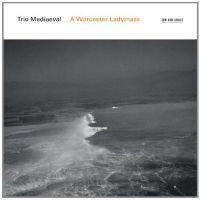 Trio Mediaeval: A Worcester Ladymass (ECM)
Trio Mediaeval: A Worcester Ladymass (ECM) This is an imaginative reconstruction of a 13th-century Mass to the Virgin, mostly made up of surviving scraps and fragments of polyphony composed by the Benedictine monks of the Abbey of St Mary’s in Worcester. Trio Mediaeval don’t pretend to give us authenticity; this music wasn’t written for performance or meant to be ordered in any particular sequence. British Minimalist Gavin Bryars was asked to add to the work, composing a Credo and a Benedicamus domino to complete the set of 20 pieces. Nor would it have been sung by male voices, but Trio Mediaeval’s cool, vibrato-free sound approaches perfection, giving many of the pieces brightness and lift. Listen to the disc without following the track listing – after the stark setting of Benedicta/Virgo Dei genitrix, Bryars’s Credo steals in – the language less bare and less consonant, but not distractingly so. And it’s wonderfully recorded in a remote Austrian monastery with a glowing, resonant acoustic.
Watch Trio Mediaeval perform
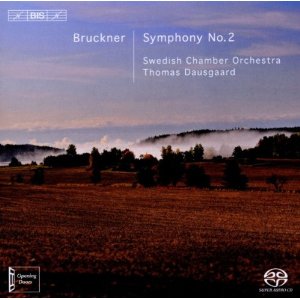 Bruckner: Symphony No 2 Swedish Chamber Orchestra/Thomas Dausgaard (Bis)
Bruckner: Symphony No 2 Swedish Chamber Orchestra/Thomas Dausgaard (Bis)
You don’t expect Bruckner to sound this charming. The composer’s final three symphonies are colossal late-Romantic breeze blocks, austere, stately and majestic. The lesser-known 1872 Second Symphony already prefigures some of Bruckner’s tics – shimmering strings at the opening, an earthy scherzo and the characteristic duplet-triplet rhythm, which dominates the later works. In this slimmed-down Swedish performance it sings and dances – a 40-piece orchestra can react with a fleetness which the Vienna Philharmonic can’t match; Thomas Dausgaard’s direction suggests he’s steering a lightweight racing bike rather than manoeuvring an oil tanker. The sextuplets on high strings at the start are so cleanly articulated, and Bruckner’s galumphing bass lines are for once audible as melodies.
Listen to the beautiful wind writing, which looks back to Schubert and Schumann. Dausgaard’s slow movement is compelling – it’s great to hear those slow Brucknerian chord progressions for the first time in this work. In this symphony there’s no cymbal-capped climax, but the journey still thrills. Dausgaard’s witty scherzo delights, and the finale ends things in high style – Bruckner’s abrupt, almost brusque coda bringing us into bright, breezy daylight.
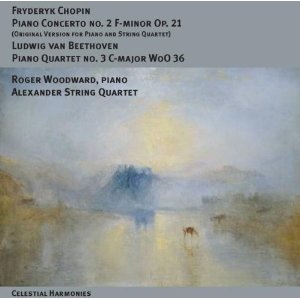 Chopin: Piano Concerto No 2 (version for piano and string quartet); Beethoven: Piano Quartet No 3 Roger Woodward (piano) with the Alexander String Quartet (Celestial Harmonies)
Chopin: Piano Concerto No 2 (version for piano and string quartet); Beethoven: Piano Quartet No 3 Roger Woodward (piano) with the Alexander String Quartet (Celestial Harmonies) Chopin’s own quartet arrangement of the F-Minor Concerto doesn’t sound like a diluted version of the orchestral version; what’s striking is how successfully Roger Woodward manages the tricky balance between piano and solo strings. If anything, the reduced tutti opening is more successful, with not a hint of muddiness or greyness. Woodward’s playing is as benignly effortless as always, without a trace of ego. The sublime Larghetto too gains from the extra transparency and the Allegro vivace swings and dances slyly. Only once did I forget that this is a chamber performance – surprised to hear the solo horn call chiming out on cello a few minutes from the close.
Beethoven’s Piano Quintet No 3 was written when its composer was 15, in 1785. The athletic piano part is rarely silent, the solo strings occasionally a little subservient, though they do get the chance to sing in the central Adagio con espressione. This is music of precocious, radiant geniality. Woodward’s Bösendorfer makes a glorious sound, matched by the Alexander Quartet. And it’s on the Celestial Harmonies label, so the recording quality is outstanding. Woodward’s erudite notes are fascinating.
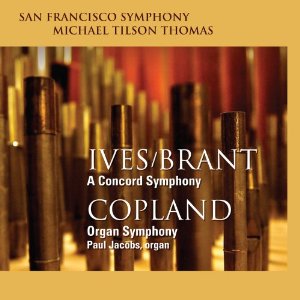 Ives/Brant: A Concord Symphony; Copland: Organ Symphony San Francisco Symphony Orchestra/Michael Tilson Thomas, with Paul Jacobs (organ) (SFS)
Ives/Brant: A Concord Symphony; Copland: Organ Symphony San Francisco Symphony Orchestra/Michael Tilson Thomas, with Paul Jacobs (organ) (SFS)
Charles Ives’s rambling Concord Sonata, published in 1920, is a famously intractable, inaccessible piece. So difficult that certain chords can only be sounded by lowering a wooden plank onto the piano keyboard, it baffles, moves and astounds by turns. As with much of Ives’s more outré work, one wonders if he knew exactly what this near-unplayable music would ever sound like. Henry Brant’s orchestral reimagining of the work, written between 1958 and 2004, doesn’t solve any structural problems, but hearing Ives’s craggy dissonances played on loud brass is thrilling, and the homely introspection of the opening to The Alcotts nicely caught – listen out for the Beethoven quotations shortly afterwards. Brant’s orchestration is more polished and idiomatic than genuine Ives – listen to a bold performance of the Fourth Symphony and the effect should be wild and chaotic. But Brant’s orchestral colours mean that the piece sounds far more sophisticated – melodies emerge more clearly, and there’s a feeling of lightness and space.
Aaron Copland’s rarely heard 1925 Organ Symphony presents fewer problems, unless you’re expecting Appalachian Spring-style folkiness. Copland’s early music can be stark and angular – the more jagged writing here suggests skyscrapers rather than prairies. Copland treats his organ as an orchestral instrument, a beefed-up woodwind soloist. The quiet, pastoral opening leads into a swinging scherzo, but best of all is the longer final movement, its majestic close shocking, haughty and triumphant. Excellent performances and superb, natural-sounding production.
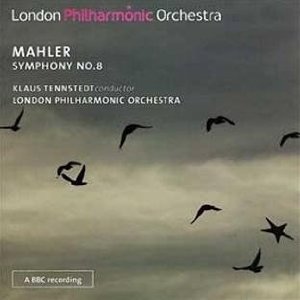 Mahler: Symphony No 8 London Philharmonic Orchestra and Choir, London Symphony Chorus, vocal soloists/Klaus Tennstedt (LPO)
Mahler: Symphony No 8 London Philharmonic Orchestra and Choir, London Symphony Chorus, vocal soloists/Klaus Tennstedt (LPO)
Mahler’s extravagant "Symphony of a Thousand" can only work when it’s led by a believer. Klaus Tennstedt’s live reading, taped by the BBC in 1991 in a Royal Festival Hall barely able to contain the sonic shockwaves released, is sensational – a Bernstein-style love-in which convinces on every level. There’s the London Philharmonic’s thrilling delivery – wonderful brass just about staying the course for 87 minutes, and the care with which Mahler’s frequently delicate colours are painted. The opening tutti roar is a stunner, but equally startling is the start of the first movement’s development, tubular bells punctuating string pizzicati and angular march figures in the winds. The movement’s final Gloria patri domino is overwhelming. It's such a surprise then to move to the chillier, Sibelian colours of the second movement’s orchestral prelude, played with devastating rawness by Tennstedt.
The choral sound is rich, weighty and believable, and Tennstedt’s vocal soloists are consistently inspired; I particularly enjoyed hearing Susan Bullock and Jane Eaglen soaring above the massed forces. It’s a work that needs to be heard in concert; this performance grips from the opening organ pedal through to those ecstatic ascending major ninths on trumpets.
 Mozart: Symphonies Nos 39 & 41 English Baroque Soloists/Sir John Eliot Gardiner (SDG)
Mozart: Symphonies Nos 39 & 41 English Baroque Soloists/Sir John Eliot Gardiner (SDG)
Mozart is the one classical composer I have had problems with; his music suffers when treated with too much affectionate gloss and the harmonies can become cloying rather than piquant. However, these live performances of two of the mature symphonies have had me leaping around with delight. They’re live, originally issued to audience members at London’s Cadogan Hall in February 2006 shortly after the concert had finished, and now given wider release. Mozart on period instruments is now standard practice, and the playing in both symphonies is predictably high-class. The spacious introduction to Symphony No 39 is characterised by limpid wind playing, with vibrato-free low flutes adding delicious recorder-like colours. Listen to the magical passage two minutes before the symphony’s close, when questioning bassoons and clarinets lead us out of the darkness into a reprise of the main theme, fearlessly articulated by Gardiner’s strings.
Symphony No 41 is equally invigorating. There’s no hint of pomposity in the swaggering opening, underpinned here with clear timpani strokes. The closing Molto allegro explodes with joy and the upfront recording adds to the physical excitement.
 Winter Sketches: Russian Music for Accordion Bjarke Mogensen (Orchid Classics)
Winter Sketches: Russian Music for Accordion Bjarke Mogensen (Orchid Classics)
Tchaikovsky used four accordions in his Orchestral Suite No 2 of 1883, and Prokofiev wrote for the Russian bayan in the 1930s. This instrument has a long history in Russia – hence Bjarke Mogensen’s nicely chosen recital of folk-tinged music, a mixture of transcriptions and works originally composed for accordion. You can sense the vodka-tinged melancholy, and Mogensen’s playing is so subtly coloured and imaginative that there’s literally never a dull moment. It’s difficult to name highlights, but Londonov’s witty Two Russian Folk Songs are a delight, its tiny jabbing dissonances delicious and piquant. Solotaryov’s Chamber Suite is moody and bluesy.
Arrangements of two pieces from Prokofiev’s Love for Three Oranges are goofy fun, and I loved the low, wheezing chords which open Chernikov’s take on the Volga Boat Song arrangement. There’s nothing profound here, but the sense that the musical material exactly matches the instrument’s capabilities.
Watch Mogensen play Prokofiev
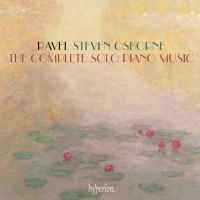 Ravel: The Complete Solo Piano Music Steven Osborne (Hyperion)
Ravel: The Complete Solo Piano Music Steven Osborne (Hyperion)
Ravel can be easy to admire and difficult to love. What Steven Osborne seems to manage in this immaculately produced survey of the composer’s piano music is to reveal the warmth and tenderness in so many of these pieces – both personal qualities which this most fastidious of musicians conspicuously lacked. The darkness is here too – a black, virtuoso account of Gaspard de la nuit, and of Osborne’s own performing edition of La Valse, where the sense of collapse is truly terrifying, a dance of death as vivid as that in Stravinsky’s Rite.
After which, you’ll need some light relief, and the less oppressive works captivate. Le Tombeau de Couperin sparkles – be dazzled by Osborne’s fearless closing Toccata, and witness time standing still in the Pavane, evidence that Ravel did indeed possess a heart. It all fits on two generously filled discs – miraculous accounts of the Sonatine, Miroirs and the Valses nobles et sentimentales along with the miniatures. Osborne’s Hyperion recording of the Debussy Préludes is already a market leader; this Ravel set is equally good.
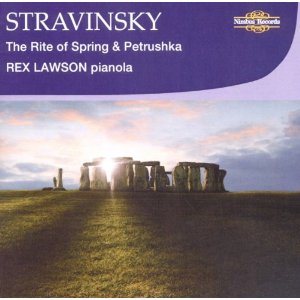 Stravinsky: Works for Pianola Rex Lawson (Nimbus)
Stravinsky: Works for Pianola Rex Lawson (Nimbus) Launched in 1897, the Aeolian Company’s Pianola rapidly established itself as the standard player piano – essentially a modified piano capable of reproducing music recorded by punching holes in strips of paper. It’s wrong to think of the instrument as a primitive jukebox – a player piano is controlled by its player. The speed at which the piano roll passes through the mechanism needs to be adjusted, and foot pedals generate suction which controls dynamics. It’s hardly surprising that Stravinsky was intrigued by the pianola’s possibilities – not least for the fact that when making the rolls there’s no need to be restricted to using two hands. The versions of Petrushka and The Rite of Spring were made by the composer in the early 1920s, with the help of assistants – these are not real-time transcriptions of Stravinsky’s playing. What we do hear is fascinating – British pianolist Rex Lawson’s interpretations of the Stravinsky piano rolls. The Étude for Pianola is a dazzling, dissonant mélange of Spanish dance tunes, full of widely spaced chords and mechanical ostinati.
Of the two ballets, Petrushka comes off best – the Dance Russe exhilarating, and the final Shrovetide Fair sequence dazzles. But what can start to grate is the lack of dynamic contrast, despite Lawson’s best efforts. Accompanying figures have unnatural prominence, and this becomes more of an issue in The Rite, where Stravinsky’s melodies need careful balancing if they’re to sing in the orchestral version. Here, it’s all a bit relentless – often amazingly exciting, as in the Danse de la terre and Danse sacrale, but the incredible power and high volume soon become exhausting.
Watch Rex Lawson perform
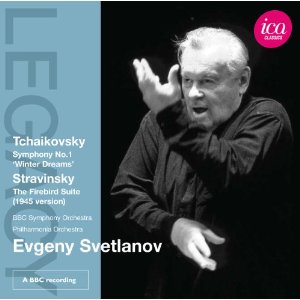 Tchaikovsky: Symphony No 1; Stravinsky: Firebird Suite (1945 version) BBC Symphony Orchestra, Philharmonia Orchestra/Evgeny Svetlanov (ICA Classics)
Tchaikovsky: Symphony No 1; Stravinsky: Firebird Suite (1945 version) BBC Symphony Orchestra, Philharmonia Orchestra/Evgeny Svetlanov (ICA Classics)
Overshadowed by the later works, Tchaikovsky’s First Symphony isn’t played as often as it should be. It’s refreshingly free of the doom-laden atmosphere which can make the mature symphonies uneasy listening. It still sounds unmistakably Russian, despite the composer’s desire to write a symphony more obviously Western-influenced than those by his predecessors. It’s heard here in a charismatic, nicely recorded performance from the Barbican in 2002, in what turned out to be Evgeny Svetlanov’s final concert – he died just a few weeks later. Fascinating to hear how the BBC players sound so idiomatically Slavic, with bold wind and brass playing supported by dark, rich string tone. The concert closed with an incandescent performance of Rachmaninov’s The Bells - surely ICA Classics have missed a trick by not releasing this as well.
The coupling is a 1995 Philharmonia account of Stravinsky’s final thoughts on The Firebird. The 1945 suite is more transparently orchestrated than the 1919 version and includes more of Stravinsky’s magical linking passages. Under some conductors it can sound brittle, but Svetlanov’s penchant for rich textures and balletic sense of rubato mean that we’re still very much looking back to the 19th century. As with the Tchaikovsky, the solo winds excel. The Danse infernale struts with barbaric swagger, with excellent trombone smears and whooping horns. And listen to Stravinsky’s subtle 1945 change to the final 7/4 apotheosis, with the brass chords more clipped and detached.
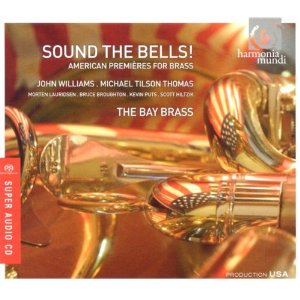 Sound the Bells! American Premières for Brass: music by John Williams, Michael Tilson Thomas, Morten Lauridsen, Bruce Broughton, Kevin Puts and Scott Hiltzik The Bay Brass (Harmonia Mundi)
Sound the Bells! American Premières for Brass: music by John Williams, Michael Tilson Thomas, Morten Lauridsen, Bruce Broughton, Kevin Puts and Scott Hiltzik The Bay Brass (Harmonia Mundi) Listening to this glorious CD of American brass music after the Ives/Copland disc reviewed above got me thinking about what gives so many of these works their unmistakable flavour – something to do with the wide intervals, the syncopated rhythms, the melodies which so often curve upwards rather than down. The oldest work on this disc dates from 1980, the most recent from 2009. The language is unashamedly tonal and defiantly, unapologetically positive. Brass ensemble music can easily become dull; there’s little chance of that here when each work is so imaginatively and idiomatically scored. Michael Tilson Thomas’s Street Song seems at times to channel the spirit of the composer’s mentor Leonard Bernstein, and Tilson Thomas knows exactly what a good brass group can do – check out those wonderful slow trombone slides in the second movement.
The three John Williams works are high-octane easy listening, technically brilliant showpieces. Parts of Bruce Broughton’s Fanfares, Marches, Hymns and Finale recall B-movie soundtracks and Shostakovich-style manic energy. Kevin Puts’s Elegy offers much-needed repose before the percussive handclaps of Scott Hiltzik’s Spirals. The playing by San Franscisco-based Bay Brass is phenomenal and spiritual uplift is guaranteed.
Share this article
more Classical music
 Sabine Devieilhe, Mathieu Pordoy, Wigmore Hall review - enchantment in Mozart and Strauss
Leading French soprano shines beyond diva excess
Sabine Devieilhe, Mathieu Pordoy, Wigmore Hall review - enchantment in Mozart and Strauss
Leading French soprano shines beyond diva excess
 Špaček, BBC Philharmonic, Bihlmaier, Bridgewater Hall, Manchester review - three flavours of Vienna
Close attention, careful balancing, flowing phrasing and clear contrast
Špaček, BBC Philharmonic, Bihlmaier, Bridgewater Hall, Manchester review - three flavours of Vienna
Close attention, careful balancing, flowing phrasing and clear contrast
 Watts, BBC Symphony Orchestra and Chorus, Bignamini, Barbican review - blazing French masterpieces
Poulenc’s Gloria and Berlioz’s 'Symphonie fantastique' on fire
Watts, BBC Symphony Orchestra and Chorus, Bignamini, Barbican review - blazing French masterpieces
Poulenc’s Gloria and Berlioz’s 'Symphonie fantastique' on fire
 Bell, Perahia, ASMF Chamber Ensemble, Wigmore Hall review - joy in teamwork
A great pianist re-emerges in Schumann, but Beamish and Mendelssohn take the palm
Bell, Perahia, ASMF Chamber Ensemble, Wigmore Hall review - joy in teamwork
A great pianist re-emerges in Schumann, but Beamish and Mendelssohn take the palm
 First Persons: composers Colin Alexander and Héloïse Werner on fantasy in guided improvisation
On five new works allowing an element of freedom in the performance
First Persons: composers Colin Alexander and Héloïse Werner on fantasy in guided improvisation
On five new works allowing an element of freedom in the performance
 First Person: Leeds Lieder Festival director and pianist Joseph Middleton on a beloved organisation back from the brink
Arts Council funding restored after the blow of 2023, new paths are being forged
First Person: Leeds Lieder Festival director and pianist Joseph Middleton on a beloved organisation back from the brink
Arts Council funding restored after the blow of 2023, new paths are being forged
 Classical CDs: Nymphs, magots and buckgoats
Epic symphonies, popular music from 17th century London and an engrossing tribute to a great Spanish pianist
Classical CDs: Nymphs, magots and buckgoats
Epic symphonies, popular music from 17th century London and an engrossing tribute to a great Spanish pianist
 Sheku Kanneh-Mason, Philharmonia Chorus, RPO, Petrenko, RFH review - poetic cello, blazing chorus
Atmospheric Elgar and Weinberg, but Rachmaninov's 'The Bells' takes the palm
Sheku Kanneh-Mason, Philharmonia Chorus, RPO, Petrenko, RFH review - poetic cello, blazing chorus
Atmospheric Elgar and Weinberg, but Rachmaninov's 'The Bells' takes the palm
 Daphnis et Chloé, Tenebrae, LSO, Pappano, Barbican review - lighting up Ravel’s ‘choreographic symphony’
All details outstanding in the lavish canvas of a giant masterpiece
Daphnis et Chloé, Tenebrae, LSO, Pappano, Barbican review - lighting up Ravel’s ‘choreographic symphony’
All details outstanding in the lavish canvas of a giant masterpiece
 Goldscheider, Spence, Britten Sinfonia, Milton Court review - heroic evening songs and a jolly horn ramble
Direct, cheerful new concerto by Huw Watkins, but the programme didn’t quite cohere
Goldscheider, Spence, Britten Sinfonia, Milton Court review - heroic evening songs and a jolly horn ramble
Direct, cheerful new concerto by Huw Watkins, but the programme didn’t quite cohere
 Marwood, Power, Watkins, Hallé, Adès, Bridgewater Hall, Manchester review - sonic adventure and luxuriance
Premiere of a mesmeric piece from composer Oliver Leith
Marwood, Power, Watkins, Hallé, Adès, Bridgewater Hall, Manchester review - sonic adventure and luxuriance
Premiere of a mesmeric piece from composer Oliver Leith
 Elmore String Quartet, Kings Place review - impressive playing from an emerging group
A new work holds its own alongside acknowledged masterpieces
Elmore String Quartet, Kings Place review - impressive playing from an emerging group
A new work holds its own alongside acknowledged masterpieces

Add comment